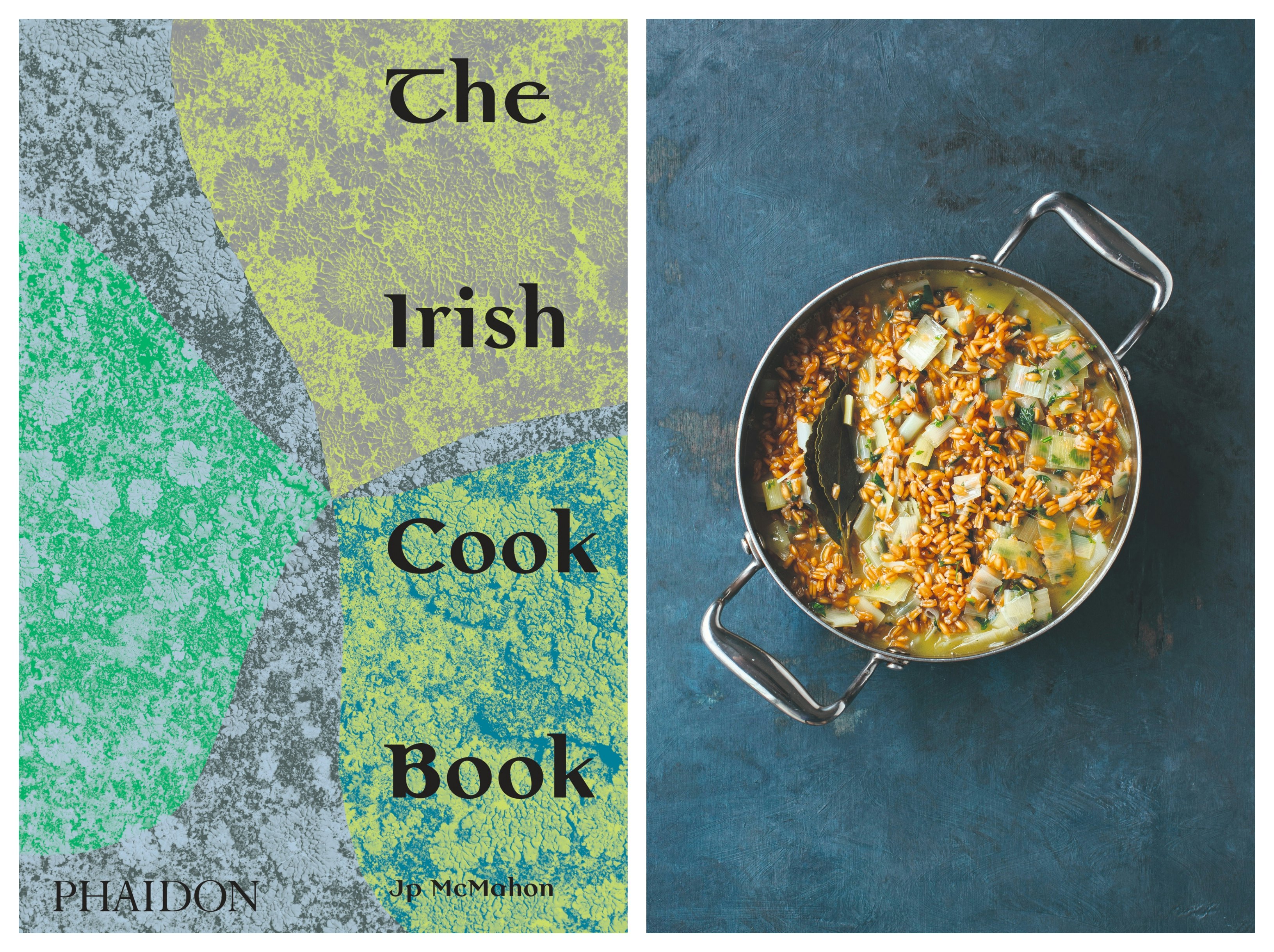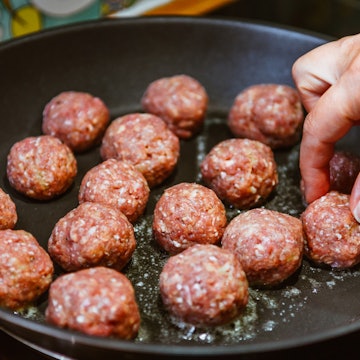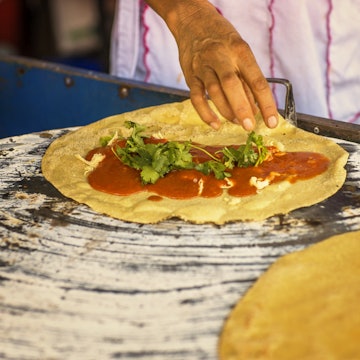
10 cookbooks to transport you to delicious European destinations
Apr 30, 2020 • 8 min read

Italy, Tuscany, Magliano, Bruschetta, bread, tomatoes and olive oil on table
Exploring Europe from the comfort of your own kitchen is simple and seamless with a selection of suitable cookbooks.
The best cookbooks transport you, mind and soul, to a destination, vivid with colour and tangible flavour whilst capturing the essence of a people by what they put on their plate. More often than not, these are the same cookbooks that are the most-thumbed, sauce-splattered and the ones you reach for time and time again for a bit of a culinary excursion.
Here are ten cookbooks, each distilling the essence of different European destinations with their ingredients and dishes.
1. Ireland: JP McMahon The Irish Cook Book (Phaidon, 2020)
The cuisine of Ireland is a marriage of spoils of the land and sea, and Michelin-starred chef JP McMahon - based in Galway along the Wild Atlantic Way - has penned the ultimate tome on Irish cuisine. Through more than 450 recipes, the chef (also the creator of the food industry symposium Food on The Edge) documents the evolution of the food and flavours of the Emerald Isle across millennia in a refined yet thorough fashion. Those who understand bacon and cabbage as typifying the Irish plate will do a double take, page-after-page.
Recipes to try: Spelt with leeks; Oysters with wild garlic butter; Dingle (mutton) pies.

2. The Nordics: The Nordic Cookbook, Magnus Nilsson (Phaidon, 2015)
Swedish chef Magnus Nilsson (of the now-closed, formerly two Michelin-starred Fäviken in Jämtland, and also familiar from Netflix’s series Chef’s Table) has produced a true authority covering the breadth of Nordic cooking. Zoning in on ingredients, technique and locality, Nilsson’s 700-recipe book traverses the entirety of the Nordic region (encapsulating Sweden, Norway, Denmark, Finland, Iceland and both the Faroe Islands and Greenland) and his recipes run the gamut from the familiar to the lesser-spotted heralds of Nordic dining, peppered with his own travel stories and photography.
Recipes to try: Skagen salad; Sienisalaatti (Finnish salted mushrooms); Tore Wretman’s Köttbullar (Swedish meatballs).
3. France: My Paris Kitchen, David Lebovitz (Ten Speed Press, 2014)
For chefs, Montagné’s La Rousse Gastronomique or Pierre Escoffier’s Le Guide Culinaire represent a pair of cookery bibles, but for the home cook French cuisine needn’t feel technical or fussy. American chef and writer David Lebovitz traded a lifetime in the kitchen at Chez Panisse and San Franscisco’s Bay Area for the 11th arrondissement and documents how to eat, shop and live like a Parisian in My Paris Kitchen.
Recipes to try: Steak with mustard butter and fries; Dukkah roasted cauliflower; Coffee crème brûlée
4. Greece: Smashing Plates, Maria Elia (Kyle Books, 2013)
Switching up the traditional surmising of Greek cuisine, chef Maria Elia pares back the flavours in Smashing Plates. Elia zones in on single ingredients (fava beans, olives, octopus, figs, etc.) that truly typify the Greek palate and are most natively used, then re-interprets Greek cuisine with her own unique twist.
Recipes to try: Slow-braised octopus with cherry tomato sauce; Apricot and orange blossom meringues; Seared scallops with watermelon.
5. Ukraine: Mamushka, Olia Hercules (Mitchell Beazley, 2015)

Set at the far-eastern reaches of the continent, Ukraine is Europe’s largest country by land (as its far-larger neighbour Russia stretches over two continents). Writer, chef and food stylist Olia Hercules hails from the south of the country, where she writes “our winters are mild, our summers long and hot and our food a cornucopia of colour and flavour; when people suggest I must be used to the cold I realize how inextricably bound the Western vision of Ukraine is with that of Russia – vast, grey and bleak”. In her debut cookbook, Hercules details her own family’s recipes from her eclectically-cuisined region with wider geographical inspiration depicting the diversity, freshness and unexpected colour of the food of “the wild East”.
Recipes to try: Pampushky (garlic bread rolls) with Red Borsch; Varenyky (stuffed Ukrainian pasta); Praz’kyy Tort (a decadent chocolate ‘Prague Cake’)
6. Belgium: The Taste of Belgium, Ruth Van Waerebeek with Maria Robbins (Grub Street, 2014)
Author Ruth Van Waerebeek muses on Belgian cuisine being Europe’s best kept secret, and writes on the inside cover: “With its hearty influences from Germany and Holland, herbs straight out of a medieval garden, and condiments and spices from the height of Flemish culture, Belgian cuisine is elegant comfort food at its best… As the Belgians say, since everybody has to eat three times a day, why not make a feast of every meal?” The recipes, peppered with Van Waerebeek’s own family traditions and methods, come accompanied by delectably rich and dramatic photography by Regula Ysewijn.
Recipes to try: Flemish-style white Asparagus, North Sea Bouillabaisse, Waterzooi; Sugar waffles from Liège.
7. Spain: Sabor, Nieves Barragán Mohacho (Fig Tree, 2017)
Simply translated as ‘flavour’, this is a collection of hearty Spanish recipes that Michelin-starred chef Nieves Barragán Mohacho (formerly of Barrafina, now owner of Sabor restaurant in London) grew up cooking. The Bilbao-born chef colourfully and deliciously documents dishes from the Basque region and beyond, accompanied by her go-to home kitchen staples she serves up when not at the pass.
Recipes to try: Potato and Chorizo Stew; Pork Belly with Mojo Verde; Tortilla with Morcilla and Piquillo Peppers
8. Italy: Gastronomy of Italy, Anna Del Conte (Pavilion, 2013)
The doyenne of Italian cuisine, 95 year-old Anna Del Conte has for decades been revered for her encyclopaedic prolificacy on Italian cuisine. Breaking down methods, regional variations and the best of produce at the optimum time of year, Gastronomy of Italy has appeared on many bookshelves since its original publishing in the late 80s. More recently, a 2013 revamp and refresh features a simpler structure, contemporary photography and comes stuffed with additional recipes.
Recipes to try: Ragù Alla Bolognese; Sarde a Beccaficu (baked stuffed sardines); Torta di Mandole (almond cake).
9. Portugal: Lisboeta: Recipes From Portugal’s City of Light, Nuno Mendes (Bloomsbury, 2017)

Having worked in New York, California and London throughout the last two-and-a-half decades, Nuno Mendes only opened his first restaurant in his home city of Lisbon (BAHR at Bairro Alto Hotel) within the last year. His 2017 book Lisboeta preceded this sort-of homecoming, and in it Nuno walks and talks the reader through a typical day in his city, pointing out his favourite places, and the incredible produce at each corner with recipes mixing classic and contemporary heralds of Portuguese cuisine.
Recipes to try: Pica Pau (fried beef fillet with pickles); Caldeirada (Portuguese fish stew); and of course Pastéis de Nata (custard tarts).
10. United Kingdom: The Complete Nose to Tail: A Kind of British Cooking, Fergus Henderson (Bloomsbury, 2012)
A decade-on update to the 1999 original mixed with his sophomore offering The Whole Beast, Fergus Henderson’s The Complete Nose to Tail is a 400+ page tome which celebrates traditional approaches, heritage cuts and places peasant dishes on a pedestal, never to be forgotten. The chef and restaurateur, who opened St. John in 1995 in London, has transformed the way a generation of chef brigades cook and in this offering for the home cook, takes simplicity, thriftiness and respect for the whole animal to another level.
Recipes to try: Devilled kidneys; Mince and Tatties; Roast bone marrow and parsley salad.
Receipe: Asparagus, Flemish style
Asperges op VlaaAAmse Wijze / Asperges a la Flamande
In Belgium, this dish is prepared with white asparagus, a special variety planted in deep trenches to which more earth is added as the stalks grow, so that the plants are never exposed to sun or air. The top layer of soil is gently removed when the shoots are mature, and they are then cut out of the ground with a special, long bladed, chisel shaped knife. This white asparagus is a great speciality of the town of Mechelen, known as the vegetable garden of Belgium. The most authentic version of this dish must be enjoyed in Belgium, since not enough of the white asparagus is produced for export. I have made this dish using fresh green asparagus with satisfying results, and recently I’ve come across bundles of white asparagus exported from Holland, which are quite good.

Ingredients:
1.35kg/3 pounds white asparagus or the freshest local asparagus you can get
100g/8 tablespoons (1 stick) unsalted butter
3 large eggs, hard-boiled and peeled
1½ teaspoons fresh lemon juice
4 tablespoons/¼ cup finely chopped fresh parsley
Salt and freshly ground black pepper to taste
Pinch of freshly grated nutmeg
Serves 4–6
Bring a large saucepan of lightly salted water to a boil.
Meanwhile, use a vegetable peeler to remove the thick woody skin of each white asparagus stalk from just below the tip to the stem end. If you are using very thin green asparagus, just trim the lower part of each stalk.
Bunch the asparagus spears together and trim them to about the same length. Tie the bundle together with kitchen string.
When the water boils, lower the heat, add the asparagus, and simmer until they are tender, 15 to 30 minutes depending on the thickness. Cover the pot only if you are cooking white asparagus; do not cover the green as it will lose its fresh colour. Remove the asparagus bundle and drain on a kitchen towel. Be careful not to break the delicate asparagus tips.
Melt the butter in a small saucepan over low heat. If the hard-boiled eggs are completely cold, plunge them for 1 minute into the asparagus cooking water to reheat and then peel.
In a small mixing bowl, mash the eggs with a fork. Add the melted butter, lemon juice, and parsley. Season with salt, pepper, and nutmeg. Stir to mix.













